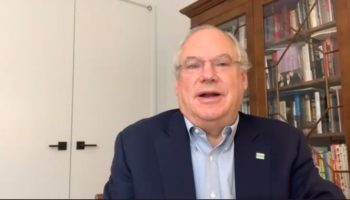
DOT Commissioner Hank Gutman speaking at the 174th CityLaw Breakfast. Image Credit: CityLand.
Today, October 29, 2021, Department of Transportation Commissioner Hank Gutman spoke at the 174th CityLaw Breakfast. Commissioner Gutman spoke on “Reimagining How Freight Moves in New York City.” Professor Ross Sandler, Director of the Center for New York City Law provided opening remarks. This Breakfast was sponsored by ConEdison, Greenberg Traurig, and Verizon. This was the eighth virtual CityLaw Breakfast as in-person events are not feasible at this time due to the COVID-19 pandemic.
Commissioner Gutman began his talk by discussing how the City had already been in the process of reimagining how people move around when he took his position as Commissioner. He discussed how the pandemic transformed what New Yorkers wanted out of their public spaces, saying “the people want their streets back” as he highlighted the successes of the open streets and open restaurant programs. Commissioner Gutman said that while the City has made progress on how to move people, there was still much work to be done on how to move freight around the city.
According to Commissioner Gutman, nearly 90 percent of goods brought into New York City are brought in by trucks. As trucks are often big, or oversized for city streets, they can also cause damage to roads, including the BQE. Trucks contribute to traffic and pollution. Commissioner Gutman said that simply making trucks smaller won’t fix the issue either, as smaller trucks may mean more trucks needed on the road, further contributing to pollution and traffic. In improving freight transport, trucks need to be cleaner and more efficient.
Commissioner Gutman said that the issue of freight movement is a mutli-agency issue, so the Department of Transportation cannot handle it alone. The City needs to reimagine how goods move into the city (including other means like trains or waterways) and how they move throughout the city (through cleaner, more efficient trucks and other means of transportation). Commissioner Gutman highlighted how waterways were frequently used to move garbage and recycling, but could be used more to move freight into the city and cited how private companies like Amazon or UPS show how successful moving freight by water can be.
Commissioner Gutman highlighted methods of making deliveries more efficient including using off-peak hours for deliveries and expanding neighborhood loading zones. He also discussed how the City incentivizes companies to switch to cleaner, more efficient trucks and how electric charging stations have been added for vehicles citywide.
Commissioner Gutman discussed how some solutions to improve the freight issue in New York City are dependent or restricted by statewide decisions and laws made in Albany. For example, weight limits on trucks are hard to enforce because the Department of Transportation requires approval from the state to use technology to automatically weigh trucks. The technology has only been approved for use on a small portion of the BQE. Other issues with the state include the growing use of cargo bikes, which can help replace some trucks for deliveries. The state restricts the size of these cargo bikes, and according to Commissioner Gutman, the restriction is lower than the industry standard, so it is harder for businesses to purchase cargo bikes that can operate within the city. Overall, Commissioner Gutman believes there isn’t a single answer or solution, but that interagency cooperation and using ideas from many different sources can help transform freight movement within New York City.
To view Commissioner Gutman’s powerpoint presentation, click here.
To watch the breakfast, click here or watch the video below:
WATCH VIDEO:

